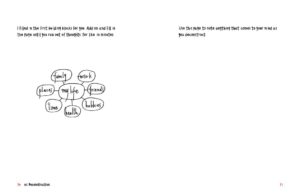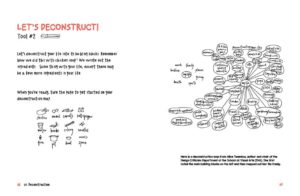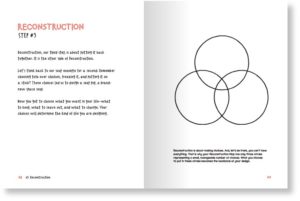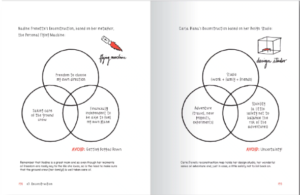It’s the last week in March and does anyone else feel like time is flying by but nothing is really happening? Things are happening, of course, but nothing tangible, nothing final, nothing with closure.
And I can’t help but feel tired and restless at the same time. I sit at work and wonder what I’m doing there. Is this what I want to be doing? Life is going by so fast, is this how I want to be spending it?
I look back at the decisions and choices I’ve made and can see how they brought me here. How each choice leads to another and eventually, you’re either where you want to be, or you’re further away from it. And then I tell myself I have all the time in the world to change things, but what do I want to change? Seriously, I’ve had like five jobs already, maybe I don’t even know what will make me happy. Maybe it’s time for me to stop running around and start taking more time to think through that question: what do I want?
Last week I shared a video by Ayse Birsel. A reader then sent me her TedTalk and recommended I explore more about Ayse. So I did. And I got this jolt of energy when she started talking about how to “design your life.”
It’s based on this concept that in order to live your ideal life, you have to make what you ‘want’ and what you ‘need’ coexist. Because you may want to be artistic and you may want to travel 10 months out of the year, but you still need to buy food and planet tickets. And it’s in this space of ‘want’ and ‘need’ that so many of us get tripped up. We forget the things we really want and instead focus too much on the ‘need’ – money, security, etc.
Beyond the larger choices of life, like our job, many of us are frozen by the myriad of choices we face on a daily level. Should we move apartments? Should we get a dog? Should we buy this carpet? Should we pack lunch or just buy it? How much ‘want’ do we allow ourselves to attain and how much ‘need’ should be save for?
Slovene philosopher, sociologist and legal theorist Renata Salecl believes, “overwhelming choice creates the feeling of anxiety. What do I really want? It pacifies people. We’re frozen in a state of indecisiveness when there are too many choices.”
Starbucks proudly advertises a choice of 80,000 different drinks combinations. Yet research shows that if you’re surrounded by an abundance of options, you typically end up less satisfied with your final decision than if you’d been given fewer options in the first place. (Maybe that’s why I no longer drink Starbucks??)
Salecl recalls a story her law professor once told the class. When it came to restaurants, he gets very anxious to choose wine. He’s afraid people will laugh at him. If he chooses too expensive bottle, it’ll appear he’s showing off. If he chooses too cheap, he’ll look like a cheapskate. So he always chooses one in the middle and insists on paying for it in order to appease the anxiety and guilt in regard to this choice
When we say we’re afraid others will laugh at us in regard for us choices, we invoke the need to be regarded by others. And this is where sometimes, we aren’t choosing what’s right for us. Instead, we’re choosing things based on how we think we’ll be perceived.
Choices Provoke Anxiety for a couple reasons:
1. We choose what other people are choosing
2. We try to make an ideal choice
3. Choice always involves a loss
Ayse believes that in order to live more freely, to truly get to that space between ‘want’ and ‘need’ you need to go through some deconstruction.
In deconstruction you pick out the qualities that define you and your life. Then you think about your heroes, the people you idolize. What qualities and values do they have that make you idolize them? What kind of life do they have? (Are they explorers? Are they generous?)
Then you reconstruct yourself.
Reconstruction is about making choices. And let’s be frank, you can’t have everything. That is why your Reconstruction Map has only three circles, representing a small, manageable number of choices. What you choose to put in these circles becomes the backbone of your life. And in order to start living your truth, to find that career and work/life balance you’re looking for, you need to take the time to deconstruct your values and reconstruct your life according to those values. .
“In order to really put something back together, you have to understand that you can’t have everything. There’s always some type of compromise.”
When it comes to making choices, this three circle diagram should be used for everything. Think about it terms of buying or renting your next place. There are dozens of things we want our perfect place to have – good location, right cost, impeccable quality, close to transportation or far enough away from transportation.
You’ll never get everything you want. So instead, try for the three (or two) most important things. Is your commute to work the most important? Or is it being close to a park? Can you sacrifice a longer commute if it brings you more joy on the weekends?
This morning, take some time to start your ‘designing your life’ project based on Ayse Birsel’s book – Design the Life You Love, A Step-By-Step Guide to Building A Meaningful Future.
-
- Deconstruct Yourself
- Find Your Values
- Reconstruct Yourself With 3 Most Important Values
- Start making choices that only reflect those values.
The point of this exercise is to cut out all the unnecessary choices you shouldn’t even be debating. The point is to whittle down your decisions to ones that only support your core values. Because you have to actively make decisions that support the life you want. This means saying ‘no’ to things that take you away from that ideal life and saying ‘yes’ to things that do – things may be scary, uncomfortable and hard at times.
Because life is all about choices and in order to get out of this paralyzing limbo of indecisiveness or this chaotic mess of too many wrong choices, let’s simplify things and start making decisions and letting in opportunities and choices that support our values.




